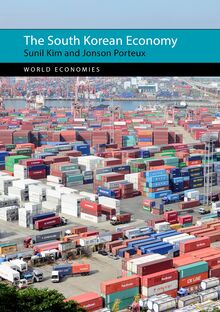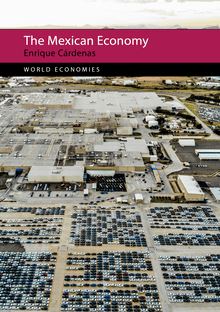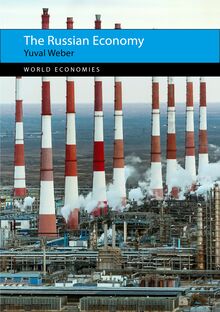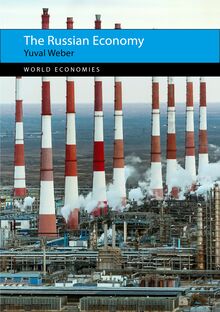-
 Univers
Univers
-
 Ebooks
Ebooks
-
 Livres audio
Livres audio
-
 Presse
Presse
-
 Podcasts
Podcasts
-
 BD
BD
-
 Documents
Documents
-
- Cours
- Révisions
- Ressources pédagogiques
- Sciences de l’éducation
- Manuels scolaires
- Langues
- Travaux de classe
- Annales de BEP
- Etudes supérieures
- Maternelle et primaire
- Fiches de lecture
- Orientation scolaire
- Méthodologie
- Corrigés de devoir
- Annales d’examens et concours
- Annales du bac
- Annales du brevet
- Rapports de stage
La lecture à portée de main
Vous pourrez modifier la taille du texte de cet ouvrage
Découvre YouScribe en t'inscrivant gratuitement
Je m'inscrisDécouvre YouScribe en t'inscrivant gratuitement
Je m'inscrisEn savoir plus
Vous pourrez modifier la taille du texte de cet ouvrage
En savoir plus

Description
South Korea has the tenth largest economy in the world and is one of only two Asian members of the OECD. It has achieved this remarkable level of economic development since its independence from Japan in 1945. Indeed, it has achieved this transformation, exceptional for any postcolonial state, despite one of the most brutal fratricidal conflicts fought since the Second World War. Sunil Kim and Jonson Porteux chart this astonishing economic and political development and explain the puzzle that is the South Korean economy.
The authors examine how South Korea has developed a highly innovative economy based on advanced technologies and infrastructure – counter-intuitively, given its postcolonial legacy of military leaders and lack of fully developed free markets. The longstanding family-owned and run industrial conglomerates – the chaebol – characteristic of the Korean economy are shown to have been behind the shift to high-tech industrialization, albeit under the strict influence of the state. The challenges of increased global interconnectedness, the precarious and fragile relationship with North Korea, the slowdown of domestic demand, recent assaults on the chaebol and their families, together with the impact of the Covid-19 pandemic, are furthermore addressed.
The book offers new insights and frameworks for understanding the fascinating history and future trajectory of South Korea’s political economy as well as the causes and consequences of industrialization and democratization more generally.
1. Introducing the South Korean economy
2. Explaining the South Korean “miracle”
3. The transformation of state-business relations
4. Making the economy: the state-labour nexus and the Korean miracle
5. Measuring the Korean economy
6. The Korean economy: the human factor
7. Consequences of economic development
8. Conclusion
Sujets
Informations
| Publié par | Agenda Publishing |
| Date de parution | 20 octobre 2022 |
| Nombre de lectures | 0 |
| EAN13 | 9781788215411 |
| Langue | English |
| Poids de l'ouvrage | 1 Mo |
Informations légales : prix de location à la page 0,1500€. Cette information est donnée uniquement à titre indicatif conformément à la législation en vigueur.
Extrait
The South Korean Economy
World Economies
A series of concise modern economic histories of the world’s most important national economies. Each book explains how a country’s economy works, why it has the shape it has and what distinct challenges it faces. Alongside discussion of familiar indicators of economic growth, the coverage extends to well-being, inequality and corruption, to provide a fresh and more rounded understanding of the wealth of nations.
Published
Stephen L. Morgan
THE CHINESE ECONOMY
Matthew Gray
THE ECONOMY OF THE GULF STATES
Frances M. B. Lynch
THE FRENCH ECONOMY
Matthew McCartney
THE INDIAN ECONOMY
Vera Zamagni
THE ITALIAN ECONOMY
Hiroaki Richard Watanabe
THE JAPANESE ECONOMY
Enrique Cárdenas
THE MEXICAN ECONOMY
Sunil Kim and Jonson Porteux
THE SOUTH KOREAN ECONOMY
The South Korean Economy
Sunil Kim and Jonson Porteux
© Sunil Kim and Jonson Porteux 2022
This book is copyright under the Berne Convention.
No reproduction without permission.
All rights reserved.
First edition published in 2022 by Agenda Publishing
Agenda Publishing Limited
The Core
Bath Lane
Newcastle Helix
Newcastle upon Tyne
NE4 5TF
www.agendapub.com
ISBN 978-1-78821-198-7 (hardcover)
ISBN 978-1-78821-199-4 (paperback)
British Library Cataloguing-in-Publication Data
A catalogue record for this book is available from the British Library
Typeset by Newgen Publishing UK
Printed and bound in the UK by TJ Books
Contents
Acknowledgements
A note on Romanization
Tables and figures
Map
1. Introducing the South Korean economy
2. Explaining the South Korean “miracle”
3. The transformation of state–business relations
4. Making the economy: the state–labour nexus and the Korean miracle
5. Measuring the Korean economy
6. The Korean economy: the human factor
7. Consequences of economic development
8. Conclusion
References
Index
Acknowledgements
We would like to express our gratitude to Agenda Publishing for allowing us to write this book. Throughout the process Andrew Lockett and Steven Gerrard were especially encouraging and helpful. The Covid-19 pandemic threw a wrench into the process but with their assistance, we were able to push through and complete the book. Ivan Butler in turn deserves a big thanks for copyediting the book. The anonymous reviewers further added to the clarity and conciseness of the book`s arguments, for which we are grateful.
We would further like to thank Professor Ingyu Oh of Kansai Gaidai University for the initial invitation for us to collaborate on the project. Additionally, the Nam Center for Korean Studies at the University of Michigan, Kansai Gaidai University, and Kyung Hee University afforded us a wealth of resources which enabled us to have access to the necessary material and support to complete this project. We cannot thank enough our colleagues for the discussions with and encouragement from them during the various stages of the writing process. We thank in turn our respective friends and families.
Finally, we express our respect and gratitude to the late Professor Hong Yung Lee, who led and guided us through the path of the political economy of Korea together since our time at Berkeley. It is in his memory that this book is dedicated to.
A note on Romanization
Korean-language names and terms have been Romanized using the Korean government standard system adopted by the Ministry of Culture and Tourism. Following Korean custom, surnames precede given names. Exceptions are made for authors who have published in English under alternate transliterations and proper nouns with other official Romanization systems or standard English spellings that are more widely known and commonly accepted (e.g. Rhee Syngman, Park Chung Hee, Seoul, Hankyoreh , etc.).
Tables and figures
TABLES
1.1 The evolution of political institutions in Korea, 1948–87
1.2 Key features of the current political institutions in Korea in 2022
2.1 US economic assistance to Korea, 1951–60
2.2 Revision of the five-year plans, export targets, 1962–66
2.3 Trend of export ratio of manufacturing industry, 1963–73
2.4 Trend of foreign borrowing, 1962–80
2.5 Consolidation of priority loan system in Korea, 1961–81
2.6 Changes of industrial structure, 1970–80
2.7 The growth and economic concentration of chaebols
2.8 Trend of foreign borrowings in Korea, 1980–96
2.9 Share of chaebols in national economy in the 1990s
3.1 Major cases of criminal charges against chaebols, 2000–18
3.2 Dynamic changes of the Korean strong state
5.1 GDP country ranking, 1960–2020
5.2 Korea’s exports and imports, 1956–2020
5.3 Korea’s top ten export and import items (2019)
5.4 Foreign currency reserves in Korea, 1992–2020
5.5 Government (central and local) tax revenue composition of Korea in 2018
5.6 International comparison of total fertility rate (trend and projection), 1960–2060
6.1 External debt, foreign exchange reserves and exchange rates in Korea, 1993–97
6.2 Fluctuation of Korea’s sovereign rating by major credit agencies
6.3 Major policy measures imposed since the crisis
6.4 Major changes in the financial sector after the crisis, 1998–2001
6.5 Major agreements on labour reform in 1998 ( Social Pact on Overcoming the Economic Crisis by the Tripartite Commission)
6.6 Births and ageing of society in Korea, 1970–2019
6.7 Suicide rates per gender and age group in Korea, 1998–2019 (rate per 100,000)
6.8 The growth of social insurance coverage rate, 1990–99
6.9 Participation in private supplemental education programmes, 2007–19
6.10 Educational attainment in Korea in 2009 and 2019
6.11 Structures of educational expenditures in Korea and OECD (2017)
6.12 International comparison of monthly wages in Korea, US and Japan
6.13 Fatal occupational injuries per year, 2000–19
7.1 Major measure for financial liberalization in the 1990s before the crisis
7.2 The government’s rehabilitation programme for major businesses in 1999
7.3 Major “big deal” programmes after the crisis
7.4 Capital account liberalization in Korea after the crisis
7.5 Financial structure of the top ten financial institutions in Korea (2018)
7.6 Share of foreign investors in top ten business groups in Korea (January 2019)
7.7 Trend of venture startups in Korea, 1999–2019
7.8 List and status of Korea’s FTAs
7.9 Impact of “Korean Wave” in tourism and export, 2016–19
7.10 Trend of international students exchanges, 2001–19
FIGURES
1.1 Effective democracy in South Korea (selected years)
2.1 Real GDP of Korea, 1953–63 (output-side at chained PPP)
2.2 Growth of export to GDP, 1961–70
2.3 Export targets and performance of Five-year Economic Development Plans, 1967–79
2.4 Chronic shortage of capital, 1965–80
2.5 Park’s will to self-reliant economy
3.1 Comparison of the ownership structure under the recurring investment and the holding company
3.2 Number of holding companies and their subsidiaries in Korea, 2011–20
4.1 Legal and illegal disputes, 1988–2006
4.2 Unionization status of non-regular workforce in Korea, 2006–19
5.1 Annual GDP growth rates of Korea in comparison, 1961–2020 (nominal)
5.2 Economic growth of Korea, 1991–2020 (GDP per capita)
5.3 Inflation in Korea (consumer prices, annual changes)
5.4 Labour productivity comparisons (2018)
5.5 Government’s debt to GDP ratio, 1997–2019
5.6 International comparison of government expenditures on social welfare (% of GDP, 2018 or the latest available)
5.7 International comparison of government spending on pension (% of GDP, 2017 or the latest available)
5.8 International comparison of government spending on health care (% of GDP)
5.9 Changing aspects of unemployment in Korea, 1997–2018
5.10 Employment, unemployment and youth unemployment rates in Korea, 2009–20
5.11 Changes of total fertility rate in Korea
6.1 Automobile industry in Korea after the crisis, 1997–2019
6.2 Value-added and labour productivity in Japan and Korea as percentages of the US, 2000–18
6.3 Ratio of social spending per GDP, 1990–2019
6.4 Industrial robot density in Korea, Singapore, Japan and the US, 2006–19
6.5 Economic inequality in Korea, 1991–2016
6.6 Korea’s ranking in Better Life Index among OECD countries (2017)
7.1 Daewoo’s “One 150th” leverage buyout scheme
7.2 International comparison of profit structure in manufacturing firms (1995)
7.3 Flow of foreign direct investment, 1989–2005
7.4 The brave new world of FTA (“The Future of FTA at a Glance”)
7.5 International migration statistics in Korea, 2000–19
Map of Korea
Source : dikobraziy.
1
Introducing the South Korean economy
The Republic of Korea (South Korea or Korea hereafter) is a relatively new state, having been born out of colonialism under Japanese imperial rule (1910–45) and all-out civil war (1950–53) between the southern and northern halves of the peninsula. While the origins of the Korean nation are linked to antiquity (Gojoseon, c .2333–108 bce ), it is the modern period that this book is concerned with. Notwithstanding the tremendously influential pre-modern history, which should not be overlooked for a most robust understanding of what Korea as a whole is today, what makes South Korea so interesting and important from a comparative perspective is that it developed, both economically and politically, with such rapidity as to eclipse the pace set by other late developers such as Japan and Germany. South Korea, thus, despite its relative size and recent ascent into the league of industrial powerhouses and leading exporters, has generated a tremendous amount of scholarly coverage and continued fascination.
In addition to providing a concise descriptive overview, the main questions this book seeks to help answer are: What are the causes of South Korea’s political and economic miracle and the consequences thereof? Can the twin economic and political achievements be sustained, despite all the challenges in the w
-
 Univers
Univers
-
 Ebooks
Ebooks
-
 Livres audio
Livres audio
-
 Presse
Presse
-
 Podcasts
Podcasts
-
 BD
BD
-
 Documents
Documents
-
Jeunesse
-
Littérature
-
Ressources professionnelles
-
Santé et bien-être
-
Savoirs
-
Education
-
Loisirs et hobbies
-
Art, musique et cinéma
-
Actualité et débat de société
-
Jeunesse
-
Littérature
-
Ressources professionnelles
-
Santé et bien-être
-
Savoirs
-
Education
-
Loisirs et hobbies
-
Art, musique et cinéma
-
Actualité et débat de société
-
Actualités
-
Lifestyle
-
Presse jeunesse
-
Presse professionnelle
-
Pratique
-
Presse sportive
-
Presse internationale
-
Culture & Médias
-
Action et Aventures
-
Science-fiction et Fantasy
-
Société
-
Jeunesse
-
Littérature
-
Ressources professionnelles
-
Santé et bien-être
-
Savoirs
-
Education
-
Loisirs et hobbies
-
Art, musique et cinéma
-
Actualité et débat de société
- Cours
- Révisions
- Ressources pédagogiques
- Sciences de l’éducation
- Manuels scolaires
- Langues
- Travaux de classe
- Annales de BEP
- Etudes supérieures
- Maternelle et primaire
- Fiches de lecture
- Orientation scolaire
- Méthodologie
- Corrigés de devoir
- Annales d’examens et concours
- Annales du bac
- Annales du brevet
- Rapports de stage










